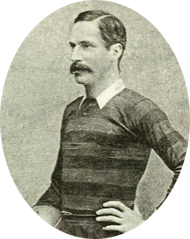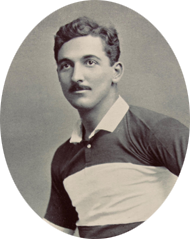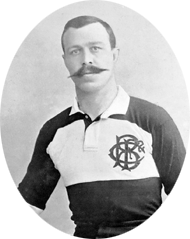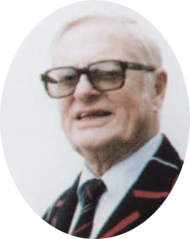Our History

WHERE CLUB RUGBY STARTED
A LIVING TRADITION THAT REACHES TO THE VERY HEART OF THE GAME
THE BEGINNING
THE BOYS FROM BLACKHEATH PROPRIETARY SCHOOL
In the 2008/2009 season Blackheath Rugby celebrated 150 years since its foundation. It must not be imagined, however, that when the boys from Blackheath Proprietary School started playing rugby on the Heath in 1858, they were a club in the sense that one would understand it today. They did not have an official secretary or treasurer until 1862 and matches would be arranged on an ad hoc basis.
The players were very young in those days. In 1863, Francis Maule Campbell was only 19 years old when he was Treasurer of Blackheath FC and also the newly formed Football Association. Fred Stokes was just 16 when he played the first game for Blackheath in 1871, 19 when he played for England and 24 when he became the second President of the RFU in 1874.

CLUB LEGENDS

FRED STOKES
1850-1928
Fred Stokes represented Blackheath FC at the meeting to form the RFU and was its 2nd President aged 24. Captain of Club and captain of the first England Rugby XX. An outstanding golfer and Kent cricketer.

HENRY VASSALL
1860-1925
Henry Holland 'Jumbo' Vassall is regarded as one the best ever rugby generals. Captain of Club 1884-1885. Credited with introducing the three-player three-quarter formation instead of the use of two three-quarters then in vogue. Captained Blackheath in 1884-85.

A. E. STODDART
1863-1915
Andrew Earnest Stoddart was a sporting god of the 1890s. Captain of England at rugby and cricket. Stoddy captained Blackheath in 1889-90 and 1890-91 and was one of the Club's finest players, turning out over 190 times. He died on 3rd April 1915.

C. B. FRY
1872-1956
Charles Burgess Fry was widely regarded as England's greatest 'All Rounder' playing cricket, soccer, rugby and was holder of the world long jump record for 25 years. Played for the Club and Barbarians.


The lack of any written documentation to establish the date of the foundation of Blackheath Football Club leaves many historians in a quandary regarding the date. There are, however, documents that indicate that rugby was instituted at the Blackheath Proprietary School around 1856, and also that the boys who founded the Club were playing on the Heath in 1858.
The memoirs of former Prep School pupils published in 1933 by J.W. Kirby BA, contain references that rugby was played by the school on the heath from that time and the names given as founders of the Club were consistent. The claim is also supported by references in Marshall’s “Football the Rugby Game” published in 1892, the date being unquestioned at the time.
Blackheath is the oldest independent Rugby club, meaning that it was not attached to any institution such as a military establishment, hospital, school or college. There were a number of institutional sides that are older than Blackheath and it was they who provided the Club’s opposition. The Proprietary School and Blackheath FC had annual fixtures against each other for many years. It was on these occasions that the school supporters would shout “Up School” to the counter cries of “Up Club”. Blackheath FC are still known as “the Club” to this day.
The development of Blackheath FC is so much a part of the development of Rugby Football that it is virtually an early history of the sport itself. By walking out of the meeting to form the Football Association, Blackheath caused the schism in football that divided it into two codes - soccer and rugby.
They were founder members of the RFU, co organisers of the first ever international match and host to many more at the Rectory Field. Blackheath hold the record for the most international caps gained by its players until the Professional era started in 1995-96.
In 1888-89 the London Society of Referees was formed by A.J Budd and G.L Jeffery. Both were captains of Blackheath. At Easter the following season, Percy Carpmael, another Club captain, founded the Barbarians touring side. In 1906-7 three players, W.S.D Craven, ‘Birdie’ Partridge and Clive Liddell, founded the Army Rugby Football Union and for many years the Rectory Field, Blackheath’s home since 1883, was the Army’s home ground in London.
CLUB LEGENDS

WILLIAM PERCY CARPMAEL
1864-1936
William Percy 'Tottie' Carpmael captained the club and was the founder and first president of the rugby union Barbarian Football Club. Carpmael not only ran the Barbarians but also represented the Ba-Baa's on twenty occasions usually as a forward.

C. H. PILLMAN
1890-1955
English lnternational before and after WW1. Credited with developing wing-forward style of play. 'Cherry' Pillman was the Club's first captain after WW1 in 1919-1920 and did much to restore the Club's fortunes. His brother, R.L. Pillman, was also an International but he did not survive the conflict.

A. T. YOUNG
1901-1933
Known as the 'Pocket Hercules', at 5ft 5ins he was a brilliant scrum-half for Cambridge and England. He was captain of the Club in 1926-27. Died of pneumonia aged 32.

C. N. LOWE
1891-1983
Cyril Nelson "Kit" Lowe is the most capped Blackheath player, representing England 25 consecutive times between 1913 and 1923. Shot down 9 enemy planes in WW1 and was shot down himself. The author, Captain W.E. Johns, supposedly based his fictional ace fighter pilot ‘Biggles’ on Cyril Lowe.

Our Present and Future.
In recent history Blackheath were running over 20 teams with only two home pitches. To ease this situation a second ground was acquired nearby at the start of 2007-08.
The site at Well Hall, Eltham, was developed into a community facility. An ‘All weather pitch’ was opened in August 2009 by representatives of the RFU, Greenwich Council and other bodies who helped to raise the funding for its installation. In September 2016 it had become imperative for the development and future health of the Club to move 1st XV matches from its long-time home at Rectory Field to these premises at Well Hall. This caused much heartache but with the ongoing developments and improvements at Well Hall, the Club now has a home base worthy of National 1 rugby.
Rectory Field continues to be used by many other teams of the Club and remains fondly in all our memories.
A great many thanks are due to our Club officials, past and present details of whom can be found within our honorarium.
Honorarium
CLUB LEGENDS

PETER PIPER
1922-2007
Wearing Colonel Begbie's blazer with the Proprietary School Badge used by the Club until 1958. He was Club President in 1966-69, Chair of the Blackheath Cricket, Football and Lawn Tennis Ltd 1977-80. Originator of the lnternational and Club Golden Oldies.

MICK SKINNER
1958-
Harlequins, England and the Club. Charismatic wing-forward known for 'Boshing' the opposition. 'Mick the Munch' was The last household rugby name to play for the Club before the professional era.

JACQUIE EDWARDS
Blackheath and England three-quarter, scoring in the final of the Women's World Cup in 1994 when they beat the USA. Six Club players took part in the tournament.
Nominations for Vice President are typically for long and exceptional service to Blackheath FC, and are approved by the Exec Committee.
Our history is very important to us, and we have been lucky to have many wonderful Presidents since we were founded, and we contunue to be thankful to all of them.
Blackheath Rugby is proud to have some important members of the community as Honorary Members - we thank them for their support.


